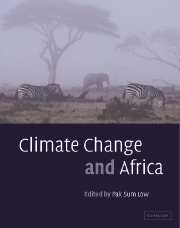Book contents
- Frontmatter
- Contents
- Notes on contributors
- Peer reviewers
- Editor's note
- Foreword
- Foreword
- Foreword
- Foreword
- Preface
- Preface
- Preface
- Preface
- List of abbreviations
- List of SI prefixes
- List of unit abbreviations
- List of chemical formulae
- Part I Science
- 1 Holocene climatic, hydrological and environmental oscillations in the tropics with special reference to Africa
- 2 The relative importance of the different forcings on the environment in Ethiopia during the Holocene
- 3 Global warming and African climate change: a reassessment
- 4 Interactions of desertification and climate in Africa
- 5 Africa's climate observed: perspectives on monitoring and management of floods, drought and desertification
- 6 Atmospheric chemistry in the tropics
- 7 Natural and human-induced biomass burning in Africa: an important source for volatile organic compounds in the troposphere
- 8 Biomass burning in Africa: role in atmospheric change and opportunities for emission mitigation
- 9 Soil micro-organisms as controllers of trace gas emissions over southern Africa
- Part II Sustainable energy development, mitigation and policy
- Part III Vulnerability and adaptation
- Part IV Capacity-building
- Part V Lessons from the Montreal Protocol
- Index
7 - Natural and human-induced biomass burning in Africa: an important source for volatile organic compounds in the troposphere
Published online by Cambridge University Press: 10 December 2009
- Frontmatter
- Contents
- Notes on contributors
- Peer reviewers
- Editor's note
- Foreword
- Foreword
- Foreword
- Foreword
- Preface
- Preface
- Preface
- Preface
- List of abbreviations
- List of SI prefixes
- List of unit abbreviations
- List of chemical formulae
- Part I Science
- 1 Holocene climatic, hydrological and environmental oscillations in the tropics with special reference to Africa
- 2 The relative importance of the different forcings on the environment in Ethiopia during the Holocene
- 3 Global warming and African climate change: a reassessment
- 4 Interactions of desertification and climate in Africa
- 5 Africa's climate observed: perspectives on monitoring and management of floods, drought and desertification
- 6 Atmospheric chemistry in the tropics
- 7 Natural and human-induced biomass burning in Africa: an important source for volatile organic compounds in the troposphere
- 8 Biomass burning in Africa: role in atmospheric change and opportunities for emission mitigation
- 9 Soil micro-organisms as controllers of trace gas emissions over southern Africa
- Part II Sustainable energy development, mitigation and policy
- Part III Vulnerability and adaptation
- Part IV Capacity-building
- Part V Lessons from the Montreal Protocol
- Index
Summary
Keywords
Biomass burning; volatile organic compounds; emissions; emission factor; combustion efficiency; emission ratio; ozone
Abstarct
Biomass burning is the burning of living and dead vegetation. 90% of all biomass-burning events are thought to be initiated by human activities. Human-induced fires are used for land management, such as shifting cultivation, agricultural expansion, deforestation, bush control, weed and residue burning, harvesting practices, and forest and grassland management. A considerable amount of biomass is burnt worldwide in household fires for cooking and heating purposes. 75% of the world's population is using wood as the main energy source. Furthermore, accidental fires, which are related to population density, political situation and poor management practices, contribute to global biomass burning. Natural fires are grassland and forest fires mainly induced by lightning.
It is estimated that 8,700 teragram (Tg) of dry matter are burnt globally per year. 66% of the biomass is burnt in savannah and agricultural fires, while biofuel and tropical forests contribute about 15% each to the total biomass burnt globally. 42% of all fires occur in Africa, 26% in South America, and 32% are distributed over the rest of the world.
Biomass burning is an important source of greenhouse gases, such as carbon dioxide (CO2), methane (CH4), and nitrous oxide (N2O). Beyond that, considerable amounts of chemically active gases such as nitrogen oxide (NO), carbon monoxide (CO) and volatile organic compounds (VOC) are released into the atmosphere, especially in tropical and subtropical regions.
- Type
- Chapter
- Information
- Climate Change and Africa , pp. 69 - 78Publisher: Cambridge University PressPrint publication year: 2005



